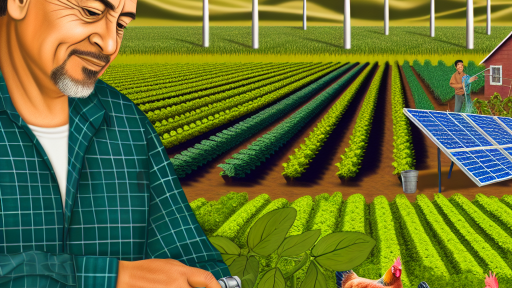Introduction to Rural Development Policies
Rural development policies play a crucial role in agriculture.
They aim to enhance the living conditions of rural communities.
Such policies focus on economic growth, social equity, and environmental sustainability.
Moreover, they boost agricultural productivity and rural livelihoods.
Importance of Rural Development Policies in Agriculture
These policies directly impact farmers and agricultural workers.
They provide access to resources, education, and technology.
In addition, they promote infrastructure development in rural areas.
Farmers benefit from better roads, irrigation, and markets.
Key Components of Effective Policy
Effective rural development policies include several key components.
- Access to credit and financial services enhances farm investments.
- Training and education programs improve farming techniques.
- Support for cooperatives fosters collaboration and collective bargaining.
- Investment in rural infrastructure supports transportation and logistics.
Influence on Agricultural Success
Sound rural development policies lead to increased agricultural output.
Farmers adopting modern practices achieve higher yields.
These policies also contribute to food security and reduced poverty levels.
Furthermore, they encourage sustainable farming practices.
Challenges and Considerations
Despite their benefits, challenges exist in implementing these policies.
Often, funding and investment gaps hinder progress.
Transform Your Agribusiness
Unlock your farm's potential with expert advice tailored to your needs. Get actionable steps that drive real results.
Get StartedAdditionally, local governance can affect policy effectiveness.
Community participation is vital for successful outcomes.
Historical Context of Rural Development Policies
Early Initiatives and Policies
In the early 20th century, policies aimed at rural development began to emerge.
Governments recognized the need for improved agricultural practices.
Programs focused on enhancing infrastructure to support rural communities.
Farmers received training to adopt modern techniques.
Post-World War II Developments
After World War II, rural development gained momentum globally.
Governments implemented more structured policies to drive agricultural productivity.
These policies often included subsidies for farmers.
Investment in irrigation systems became a priority.
The Green Revolution
The Green Revolution marked a major turning point in agricultural policies.
This movement introduced high-yield crop varieties and chemical fertilizers.
Consequently, many countries experienced significant increases in food production.
Investment in research and development played a crucial role.
Modernization and Sustainability Efforts
In recent decades, there’s been a strong shift towards sustainable practices.
Policies now emphasize environmental conservation in rural areas.
Governments aim to balance productivity with ecological responsibility.
Support for organic farming and agroecology has increased significantly.
Current Trends and Future Directions
Today, rural development policies focus on food security and resilience.
Global challenges like climate change influence policy-making.
Communities collaborate to enhance local food systems.
Innovations in technology are shaping modern agricultural practices.
Key Components of Effective Rural Development Policies Affecting Agriculture
Infrastructure Development
Infrastructure plays a vital role in agricultural success.
Adequate roads, irrigation systems, and storage facilities boost productivity.
Showcase Your Farming Business
Publish your professional farming services profile on our blog for a one-time fee of $200 and reach a dedicated audience of farmers and agribusiness owners.
Publish Your ProfileInvesting in rural transportation reduces post-harvest losses.
Accessible markets encourage farmers to sell their produce effectively.
Furthermore, reliable energy sources support agricultural operations.
Access to Financial Services
Financial services are crucial for farmers’ growth and sustainability.
Access to credit allows farmers to invest in modern equipment.
Insurance protects them against crop failures and market fluctuations.
Moreover, savings programs help farmers manage their cash flow efficiently.
Education and Training Programs
Education enhances farmers’ skills and knowledge about best practices.
Training programs enable farmers to adopt new technologies.
Workshops on sustainable farming improve long-term productivity.
Furthermore, cooperative programs foster a sense of community among farmers.
Supportive Government Policies
Government policies significantly impact rural development initiatives.
Subsidies for seeds and fertilizers make farming more affordable.
Moreover, policies that encourage research and development boost innovation.
Support for local produce can enhance food security and local economies.
Community Participation and Engagement
Involving local communities leads to better policy outcomes.
Farmers’ input is essential in designing effective programs.
Engagement fosters ownership and accountability among stakeholders.
Additionally, collaboration among various partners strengthens initiatives.
See Related Content: Comprehensive Guide To Pesticide Safety Regulations
Case Studies of Successful Rural Development Policies
Introduction to Rural Development Policies
Rural development policies play a crucial role in enhancing agricultural productivity.
These policies provide frameworks for support and resources to farmers.
Additionally, they encourage sustainable practices and community involvement.
Case Study: India’s National Rural Livelihoods Mission
The National Rural Livelihoods Mission significantly impacts farmers’ livelihoods in India.
This program focuses on skill development and self-employment opportunities.
Consequently, it has increased income levels for numerous families.
It also emphasizes financial inclusion through access to banking services.
Success Factors of the Mission
Key success factors include strong community participation.
Additionally, the mission leverages local resources effectively.
Collaboration with NGOs enhances implementation and monitoring.
Furthermore, the mission encourages women’s empowerment, leading to better agricultural outcomes.
Case Study: Brazil’s Family Farming Program
Brazil’s Family Farming Program supports small-scale farmers across the country.
This initiative provides access to credit and technical assistance.
Moreover, it facilitates market access for smallholder produce.
As a result, agricultural productivity has significantly increased.
Impact on Agricultural Success
The program helps farmers adopt sustainable practices.
Additionally, it fosters resilience against climate change challenges.
Farmers report improved crop yields and income stability.
Ultimately, the program contributes to food security within rural communities.
Case Study: Kenya’s Agricultural Sector Development Support Programme
Kenya’s programme invests in agricultural research and innovation.
Showcase Your Farming Business
Publish your professional farming services profile on our blog for a one-time fee of $200 and reach a dedicated audience of farmers and agribusiness owners.
Publish Your ProfileThis initiative promotes crop diversification and sustainable farming methods.
As a consequence, farmers benefit from increased productivity and profitability.
Innovative Approaches in the Programme
One innovative approach includes the introduction of drought-resistant crops.
Training programs enhance farmers’ skills and knowledge effectively.
Furthermore, this initiative fosters partnerships between farmers and research institutions.
Broader Impact of Rural Development Policies
These case studies showcase the diverse impacts of rural development policies.
They illustrate how targeted support can uplift farmers and communities.
Ultimately, effective rural development policies are essential for lasting agricultural success.
Uncover the Details: The Importance of R&D Funding in Enhancing Sustainable Farming Practices
The Role of Government Support and Subsidies in Rural Development Initiatives
Introduction to Government Support
Government support plays a crucial role in rural development.
This support often comes in the form of policies and regulations.
Additionally, effective government strategies can significantly enhance agricultural success.
Understanding Subsidies
Subsidies are financial aids provided by the government.
These aids help reduce the costs of production for farmers.
As a result, farmers can produce more at lower prices.
This encourages competitiveness in agricultural markets.
Types of Government Support
Government support can take several forms.
- Direct cash payments to farmers.
- Tax incentives for agricultural businesses.
- Investment in rural infrastructure.
Each type of support serves unique purposes.
Importantly, these supports foster innovation in rural areas.
Impact of Financial Assistance
Financial assistance helps stabilize farm incomes during crises.
It allows farmers to invest in better technology and training.
Moreover, this assistance can reduce unemployment in rural communities.
Challenges and Criticisms
Despite the benefits, government support faces challenges.
Some argue that it can create dependency among farmers.
Additionally, critics express concerns over sustainable farming practices.
Addressing these challenges is essential for effective rural development.
Significance of Continued Investment
Ultimately, government support and subsidies are vital for agricultural success.
They not only boost individual farmer productivity but also enhance community resilience.
Therefore, continued investment in rural development policies is essential.
Explore Further: Renewable Energy Incentives for Agriculture

Challenges Faced in Implementing Rural Development Policies in Agriculture
Limited Access to Resources
Many rural farmers lack access to essential resources.
These resources include financing, technology, and training.
Consequently, they struggle to adopt modern agricultural practices.
Poor Infrastructure Development
Infrastructure in rural areas often remains underdeveloped.
This includes inadequate roads, irrigation systems, and storage facilities.
As a result, farmers face challenges in transporting their products.
This ultimately leads to higher post-harvest losses.
Insufficient Government Support
Government policies often fail to provide needed support.
There is sometimes a lack of incentives for farmers to implement new technologies.
This leads to stagnation in agricultural growth.
Showcase Your Farming Business
Publish your professional farming services profile on our blog for a one-time fee of $200 and reach a dedicated audience of farmers and agribusiness owners.
Publish Your ProfileMarket Access and Inefficiencies
Farmers often face barriers to accessing markets.
These barriers include high transportation costs and limited information.
Moreover, market prices can fluctuate unpredictably.
As a result, this uncertainty discourages investment in agriculture.
Environmental Factors
Rural farmers frequently deal with adverse environmental conditions.
These include droughts, floods, and soil degradation.
Such challenges can diminish crop productivity significantly.
Social and Cultural Barriers
Social norms can hinder the adoption of progressive farming methods.
Older generations may resist change, affecting innovation.
Furthermore, education levels vary significantly across communities.
This affects farmers’ ability to engage with new practices effectively.
Discover More: Future of Farming Under Climate Change Legislation
Impact of Technology and Innovation on Rural Development and Agricultural Success
Enhancing Productivity
Technology boosts agricultural productivity in rural areas.
It introduces advanced tools for planting and harvesting.
Farmers leverage drones for precision agriculture.
This innovation reduces labor costs effectively.
Improving Access to Information
Information technology connects farmers with vital resources.
Mobile apps provide weather forecasts and market prices.
This access helps farmers make informed decisions.
Consequently, they can optimize their crop yields.
Facilitating Sustainable Practices
Modern technologies promote sustainable farming practices.
For example, soil sensors enhance resource management.
This technology minimizes waste and improves efficiency.
Ultimately, it leads to healthier ecosystems.
Encouraging Cooperative Models
Technological innovations foster cooperative farming models.
Farmers collaborate through digital platforms.
This collaboration enhances their bargaining power.
Consequently, they secure better prices for their products.
Driving Economic Growth
Innovative technologies stimulate rural economic growth.
They create new jobs in the agricultural sector.
Startups develop services tailored to farmers’ needs.
This growth strengthens local economies significantly.
Future Trends in Rural Development Policies
Emphasis on Sustainability
Future rural development policies will focus heavily on sustainability.
Agencies will encourage practices that reduce environmental impact.
These practices will include organic farming and agroecology.
Farmers will receive support for adopting sustainable techniques.
Consequently, communities will benefit from improved ecosystem services.
Technological Advancements
Technological integration will shape the future of rural development.
Innovations in precision agriculture will enhance productivity.
Farmers will use data analytics to optimize resource use.
Showcase Your Farming Business
Publish your professional farming services profile on our blog for a one-time fee of $200 and reach a dedicated audience of farmers and agribusiness owners.
Publish Your ProfileAdditionally, smart farming technologies will increase efficiency.
This shift will attract new investments into rural areas.
Public-Private Partnerships
Collaboration between public and private sectors will intensify.
Partnerships will foster innovation and development in rural regions.
Private companies will invest in agricultural infrastructure.
Moreover, local governments will facilitate access to funding.
This collaboration will enhance rural economies and productivity.
Focus on Education and Training
Future policies will prioritize education and training for farmers.
Investment in skill development will be essential for success.
Younger generations will be trained in modern agricultural techniques.
Workshops and mentorship programs will become more prevalent.
This emphasis will create a more knowledgeable workforce in agriculture.
Inclusion of Marginalized Communities
Policies will increasingly target marginalized communities in rural areas.
Support programs will address the unique challenges they face.
Access to resources such as land and capital will be improved.
Moreover, these initiatives will promote community engagement.
This inclusivity will foster social and economic equity.
Climate Resilience Strategies
Rural development policies will incorporate climate resilience strategies.
Farmers will adopt practices to withstand climate change effects.
These strategies will involve diversifying crops and water conservation.
Additionally, assistance will be provided for disaster preparedness.
This proactive approach will safeguard rural livelihoods.
Potential Implications for Agriculture
Increased Productivity
As a result of these policies, agricultural productivity will rise.
Farmers will use better tools and resources to yield more crops.
This increase will not only support local economies but also global supply chains.
Enhanced Food Security
Improved rural policies will contribute to greater food security.
A focus on sustainable practices will ensure consistent food production.
This stability will help meet the growing global food demand.
Environmental Benefits
Adopting sustainable practices will benefit the environment significantly.
Healthy soil and biodiversity will be restored over time.
Additionally, reduced chemical usage will lead to cleaner water sources.
Economic Growth
Overall economic growth in rural areas will be a key outcome.
New job opportunities will arise from diversified agricultural practices.
This growth will stimulate local economies and reduce poverty.
Additional Resources
Current Status of agriculture in the Caribbean and implications for …




